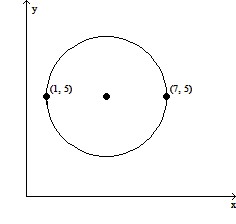Subtract.- 
A. 8.11
B. 8.1
C. 8.21
D. 9.11
Answer: A
You might also like to view...
Solve the problem.Use a graphical method to determine the approximate interval for which the second order Taylor polynomial for  at
at  approximates
approximates  with an absolute error of no more than 0.04.
with an absolute error of no more than 0.04.
A. -0.1928 ? x ? 0.7063 B. -0.5525 ? x ? 0.5525 C. -0.4310 ? x ? 0.5525 D. -0.5525 ? x ? 0.2640
Use a graphing calculator to approximate the real zeros. Give each zero as a decimal to the nearest tenth.f(x) = x3 + x2 - 11x - 11
A. 1, 3.3, -3.3 B. 1, 3.3i, -3.3i C. -1, 3.3, -3.3 D. 1, 5.5, -5.5
Write the standard form of the equation of the circle. 
A. (x + 4)2 + (y + 5)2 = 9 B. (x - 4)2 + (y - 5)2 = 9 C. (x - 4)2 + (y - 5)2 = 3 D. (x + 4)2 + (y + 5)2 = 3
Analyze the graph of the given polar curve. Include the following information: If possible, describe the shape of the graph (circle, rose curve, limacon, etc.), and state the domain, range, and maximum r-value of the graph. State whether the graph is continuous and whether it is bounded. Describe any symmetry that the graph has. Give the equations of any asymptotes or state that the graph has no asymptotes.r = 4
What will be an ideal response?